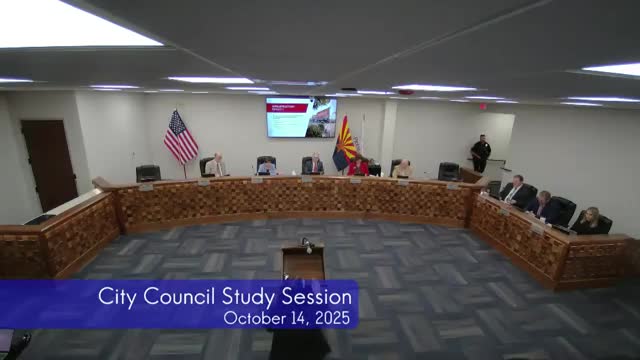Prescott details traffic-safety studies, signal coordination and grant awards
October 15, 2025 | Prescott City, Yavapai County, Arizona
This article was created by AI summarizing key points discussed. AI makes mistakes, so for full details and context, please refer to the video of the full meeting. Please report any errors so we can fix them. Report an error »

Public-works staff briefed the Prescott City Council on Oct. 14 about traffic-safety measures, grant awards and capital projects intended to reduce injuries, improve multimodal connections and close missing links in the city's bicycle and pedestrian network.
Why it matters: Council's strategic plan sets targets for fewer traffic injuries and better multimodal connections; staff connected recent grant awards and signal-timing projects to those goals.
What staff reported: Gwen Roach said the city has developed a policy to prioritize radar-speed signs ("radar speed vac signs") that cost about $10,000 each and will be deployed where signing and striping are insufficient. Roach said staff have already implemented coordinated signal timing on Willow Creek Road and other corridors and recently completed timing on SR-89 from Yavapai to Presque Isle Parkway.
Grant awards and studies: Roach said the city and the Central Yavapai Metropolitan Planning Organization (SIMPO) were awarded a $150,000 Safe Streets for All grant for a Dexter neighborhood study that includes a 15% design concept report. She also said the "Downtown Prescott Safe and Smart Streets Initiative" was awarded $600,000 and that SIMPO secured a $125,000 match so the study will come to the city at no cost. Combined grant funding discussed for these studies was described as $875,000.
Other infrastructure and grants: Staff reported spending $3,000,000 in Water Infrastructure Finance Authority (WIFA) grant reimbursement on the city's AMI meter replacement program, reducing the city's share of that project from $12,000,000 to $9,000,000. The city also used a $75,000 federal energy-efficiency grant to replace more than 200 street-light heads with LEDs and completed the SR-89 multimodal PATH study to bridge a gap for cyclists entering the city.
Timing and next steps: Roach said the Dexter Safe Streets study and the downtown study will kick off in 2026 and that staff will seek construction grants for recommended projects. She also said staff are procuring striping equipment to reduce turnaround time for pavement markings and plan to bring updated engineering standards to council in early 2026.
Ending: The council asked about project sequencing and using study results to support grant applications. Staff said the technical studies will produce counts, design concepts and recommendations that will strengthen future grant applications and support construction funding requests.
Why it matters: Council's strategic plan sets targets for fewer traffic injuries and better multimodal connections; staff connected recent grant awards and signal-timing projects to those goals.
What staff reported: Gwen Roach said the city has developed a policy to prioritize radar-speed signs ("radar speed vac signs") that cost about $10,000 each and will be deployed where signing and striping are insufficient. Roach said staff have already implemented coordinated signal timing on Willow Creek Road and other corridors and recently completed timing on SR-89 from Yavapai to Presque Isle Parkway.
Grant awards and studies: Roach said the city and the Central Yavapai Metropolitan Planning Organization (SIMPO) were awarded a $150,000 Safe Streets for All grant for a Dexter neighborhood study that includes a 15% design concept report. She also said the "Downtown Prescott Safe and Smart Streets Initiative" was awarded $600,000 and that SIMPO secured a $125,000 match so the study will come to the city at no cost. Combined grant funding discussed for these studies was described as $875,000.
Other infrastructure and grants: Staff reported spending $3,000,000 in Water Infrastructure Finance Authority (WIFA) grant reimbursement on the city's AMI meter replacement program, reducing the city's share of that project from $12,000,000 to $9,000,000. The city also used a $75,000 federal energy-efficiency grant to replace more than 200 street-light heads with LEDs and completed the SR-89 multimodal PATH study to bridge a gap for cyclists entering the city.
Timing and next steps: Roach said the Dexter Safe Streets study and the downtown study will kick off in 2026 and that staff will seek construction grants for recommended projects. She also said staff are procuring striping equipment to reduce turnaround time for pavement markings and plan to bring updated engineering standards to council in early 2026.
Ending: The council asked about project sequencing and using study results to support grant applications. Staff said the technical studies will produce counts, design concepts and recommendations that will strengthen future grant applications and support construction funding requests.
View full meeting
This article is based on a recent meeting—watch the full video and explore the complete transcript for deeper insights into the discussion.
View full meeting
